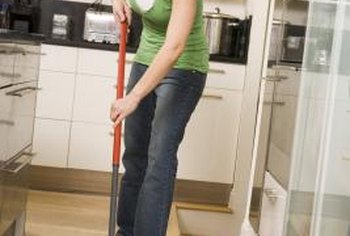How to Avoid Slippery Kitchen Floor in Restaurants
Nothing's more dangerous, or costly, than a greasy restaurant kitchen floor. Slips, trips or falls account for up to 15% or more of all workers compensation costs.
Avoid more than 90% of costly slip and fall accidents with Slip Resistant Solutions' heavy-duty non slip products. Most one-solution-fits-all floor treatment products are too mild to cut through layers of grease. Commercial or restaurant kitchen floors are typically made of red or gray quarry tile. These porous tiles make the perfect trap for grease and soap which fills the holes and makes the floor slippery. Slip Resistant Solutions' products are specifically designed for tough-to-clean restaurant kitchen floors.
There are a few common mistakes when it comes to taking good care of your restaurant flooring, such as using cheap generic solutions or bleach. You should also avoid using laundry detergent or dishwasher soap. Both contain ANIMAL FAT as an emulsifying liquid so they're extremely slippery as is. Over time they build up a residue that combines with the grease to create a slippery coating on your restaurant flooringthe exact thing you're trying to avoid.
There are several ways to apply kitchen flooring cleaning solutions. The most basic is to mix the proper amounts of cleaner and degreaser in a five gallon bucket and simply throw it across the floor. The most effective way is to use a chemical dispensing system. Some of these are permanently mounted in the kitchen. A simple system is the foam gun that attaches to the end of a hose. If your restaurant kitchen floor does not have good drainage, simply dilute the chemicals in a floor cleaning bucket, mop the floor, brush the deck, then follow up with a clean water rinse.
Follow these helpful tips for proper restaurant kitchen floor maintenance:- Once you've applied the degreaser and non slip treatment to your kitchen flooring, use the degreaser on a regular basis, at least once a day and more often if possible, to keep it free of grease and buildup.
- Make sure to use the degreaser at the recommended dilution ratio. More is not better.
- Let the degreaser sit on the floor for at least five to ten minutes or longer to emulsify the grease, then follow with a thorough hot-water rinse.
- Use a different mop for the restaurant kitchen floor than you use for the general restaurant flooring.
- Change the mop bucket and solution often to avoid "slop mopping"just spreading the dirt and grease around the kitchen flooring. The frequency depends on how dirty the floor is.
- Clean up grease spills promptly.
- Sweep up food items throughout the day.
For more helpful tips, check links below:
carpet cleaning auckland, carpet cleaner





0 Response to "How to Avoid Slippery Kitchen Floor in Restaurants"
Post a Comment